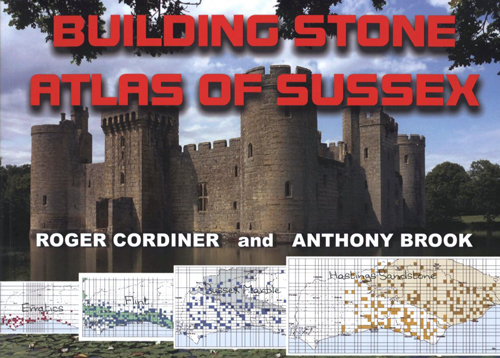
An instant reaction to this title could well be ‘Why should I buy this book when I can utilise readily available Geological Survey maps?’ But view this masterful, beautifully produced volume and you will be absolutely delighted. This is no simple Atlas, it describes and pictures in wonderful detail, over 50 rock types found in the buildings of Sussex.
Commencing with an extremely useful section of eleven pages introducing the reader to the ancient heritage of early Sussex building stones, there follows useful supplementary information, packed with delightful figures in colour. With applicable illustrations, it advises on topics such as ‘The Building Stone Landscape’, ‘Stone Quarrying in Sussex’, ‘Historic Use of Building Stones’, and even to the past coastal and river navigation of about 1000AD that assisted in the distribution of the stone types at that time. There follows a comprehensive, well laid out, easy to use, double-page spread, describing each rock type in stratigraphical order. Occasionally, two double-page spreads are used where the importance of certain rocks, such as the Hastings Sandstone, are involved. These descriptions are accompanied by excellent colour photographs of the particular building stone, both in its natural geological environment and as used within buildings. A clear colour map with grid displays the whereabouts of that stone in each of these circumstances.
In addition to the indigenous rocks of Sussex, stones used for buildings from elsewhere in the British Isles, as well as those imported from France, Belgium and some more exotic rocks from elsewhere, are carefully illustrated and detailed. Nor were the bricks and tiles of Roman construction omitted. The 148 pages of this, very reasonably priced, outstanding book, truly leave ‘no stone unturned’.
Particularly useful is the provision of archaeological and geological glossaries where the historic uses of different rock types are discussed. So much knowledge related to the early use of building stones relates to their occurrence in churches, so it was a delight to find the churches listed in an appendix. A minor shame, however, that the grid reference of each was not given. In a book so clearly packed with a vast amount of such brilliantly offered information there must be a rare mistake; I will proffer ‘ferricrete’, which uses a word for a rock differing from that as it was originally defined. But those minor petty comments are not called for in a beautiful, useful book of such quality. Buy it, admire it, make the most of it, and treasure it.
Reviewed by John F. Potter
BUILDING STONE ATLAS OF SUSSEX, by Roger Cordiner and Anthony Brook, 2017. Published: by Verite CM Ltd, Worthing, West Sussex. 147 pp. ISBN 978-1-910719-49-7. List Price: £34.99 W:
https://www.nhbs.com/building-stone-atlas-of-sussex-book (Also available from Roger Cordiner, 9, The Rowans, Grand Avenue, Worthing BN11 5AT, £30 plus £5 p&p).